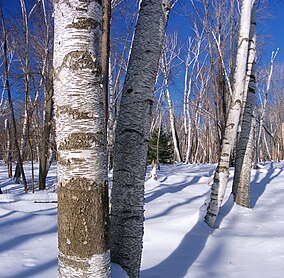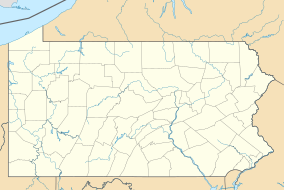Marion Brooks Natural Area
| Marion Brooks Natural Area | |
|---|---|
|
IUCN category V (protected landscape/seascape)
|
|

White birches in Marion E. Brooks Natural Area
|
|
|
Location within Pennsylvania
|
|
| Location | Benezette Township, Elk County, Pennsylvania |
| Coordinates | 41°16′35″N 78°17′16″W / 41.2763°N 78.2879°WCoordinates: 41°16′35″N 78°17′16″W / 41.2763°N 78.2879°W |
| Area | 917 acres (371 ha) |
Marion Brooks Natural Area is a state forest natural area in the Moshannon State Forest in Benezette Township, Elk County in the U.S. state of Pennsylvania. The 917-acre (371 ha) natural area is on the northwest edge of Quehanna Wild Area. Marion Brooks Natural Area, known for its large stand of White Birch, was formerly known as Paige Run Natural Area; in 1975 it was renamed for Marion E. Brooks, a pioneering environmentalist from Elk County. The Marion Brooks Natural Area is popular with photographers who come to capture images of the unique landscape.
Paper birch, or Betula alba var. papyrifera, is a large tree usually reaching a height of 50–75 feet (15–23 m), with a diameter of 1–23 inches (25–584 mm), but it may reach a height of 80 feet (24 m) with a diameter of 8 feet (2.4 m). Generally the tree is shade-intolerant, and, when grown in the open, trunks are usually short and thick; lateral, often ascending branches cover the trunk from the base. When grown in close stands, most of the trunk is branch-less base and bears a narrow open head. The bark of the trunk and older branches is chalky to creamy white, and peels in layers that are tinged in yellow and covered with horizontally-elongated lenticels. On older trunks, the bark is often rough and fissured with irregular thick scales. The twigs are stout, viscid, with first greenish hairy covering that later becomes smooth and reddish brown in color. After several years, branches turn a bright white, like the trunk, and are covered with pale, horizontally-elongated and orange-colored lenticels.
Birch buds may be ovate, sharp-pointed, and divergent, about .5 inches (13 mm) long, dark, almost chestnut brown in color, and covered with a few overlapping bud scales. These usually have downy margins. The leaves alternate, with simple ovate, 2–3 inches (51–76 mm) long, and 1.5 to 2 inches (38 to 51 mm) wide. They are firm in texture, the upper surface being dark green and the under surface light green. They are narrowed or rounded at the base, sharply toothed on the margin, and have a sharp-pointed apex. Flowers appear in late April or May, before the leaves. The staminate are arranged in layers which occur in groups of 2-3 and are about .1 to .15 inches (2.5 to 3.8 mm) long. They become longer, 3.5 to 4 inches (89 to 102 mm), in the spring. The pistillate have light green lanceolate scales and red styles, and appear in clusters 1 to 1.5 inches (25 to 38 mm) long. The fruit is cylindrical, with a short-stalked strophile about 1.5 inches (38 mm) long. The scales are long, with thick, lateral lobes, and a long terminal lobe. Seeds and small and winged, and the wings are wider than the nut. The wood, a hardwood, is diffuse, porous, rays are small and inconspicuous. The wood itself is light in color, usually light brown, tinged with red, and with thick light sap wood, and its weight is 37.11 pounds (16.83 kg) per cubic foot.
...
Wikipedia

